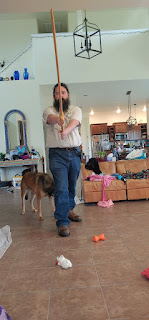Longsword - The Post Office I - Fiore's Longa and Breve
One of the points I've continuously emphasized while teaching intro to longsword is that Fiore does not have guards. Fiore has poste, which translate as "posts" or "positions," rather than "guards." There are points in Flower of Battle where he does refer to them as guards, but I'll let Fiore himself explain why I refer to them as "positions." This is from the Getty manuscript, Hatcher's translation:
Whether you call it a “post” or a “guard”, you are referring to the same stance. As a “guard” it is used defensively, that is you use it to protect yourself and defend yourself from the strikes of your opponent. As a “post” it is used offensively, that is, you use it to position yourself in such a way in relation to your opponent that you can attack him without danger to yourself.
Thus, "the guard of the lady" and "the lady's position" are both acceptable translations of posta di donna. I prefer position for the simple reason that the poste are not "guards" or "wards," but rather positions from which you can make decisions. This is based on my reading of Fiore's intent in the front material to the sword in two hands section:
We are two guards that are similar to each other, and yet each one is a counter to the other. And for all other guards in this art, guards that are similar are counters to each other, with the exception of the guards that stand ready to thrust—the Long Guard, the Short Guard and the Middle Iron Gate. For when it is thrust against thrust the weapon with the longer reach will strike first. And whatever one of these guards can do so can the other.
Ital: Noii semo doi guardie una si fatta che l'altra, e una e contraria del'altra. e zaschuna altra guardia in l'arte una simile del'altra si'e contrario salvo le guardie che stano in punta zoe posta lunga e breve e meza porta di ferro che punta per punta la piu lunga fa offesa inançi. E ço che po far una po far llaltra.
Thus, it is not the "guard" that makes the move, it is what you can do from it, and from this, my interpretation that they are positions rather than guards. For fairness, I have included the relevant sentences in medieval Italian, where you can see, yes, they are guardie. However, see the other quote - call them guards or positions, they're the same, it's what you do from it that dictates which it is in that moment. Keep in mind, I am proceeding from the supposition that the objective of drawing a sword is to end a fight; therefore, offensive action is required, otherwise, to quote an expert on the subject, "the bomber will always get through." Thus, while yes, I acknowledge Fiore quite clearly says "guards" in multiple places, he also quite clearly says it's what you do from it that matters.
Now, what does this have to do with longa and breve, my apparent subject according to the blog post? Well, to find the answer to that, we have to go to Japan. No, really.
I cannot speak for every art, but Yagyû shinkage-ryû has three centerline positions, roughly equivalent to posta longa. These are seigan, chudan, and seigan - that is, migi seigan, chudan, and hidari seigan, going from left to right. The difference between seigan and chudan is that the shoulders are rotated and while the point stays oriented on their eyes, it is now angled, producing the characteristic "shadow" (kage) of shinkage, where the body is behind the shadow of the blade. It is worth noting that shinkage also uses kurai, or "shaded," as well as kamae, or "stance."
Pictures will show this better than words. Here, have a look at my living room and a waster. Yes, I know my shoulders look hunched. They didn't feel hunched, but they also weren't my focus. No, the sword is not actually ten feet long; it's a four-footer, but my camera operator was seated, so it created perspective issues. Still, it's what I have to work with, and congratulations, you now know what I look like!
Now, all three of these positions are posta longa. They look very different, but they're all posta longa. Why is this? Return to what Fiore said above - similar positions can do similar things. This led to a realization on my part. Posta longa is not merely long and extended down the centerline - posta longa is also long and extended diagonally, and in an extreme example, posta longa can be long and extended with the arms and sword forming practically a 90-degree angle. Similarly, posta breve's characteristic is that the arms are close; breve can be with the arms close and the sword diagonal on the left or right - the German Pflug.
Combined with the admonition that Fiore makes about thrusting from longa and breve, above, this opens up a tremendous range of tactical options, and gives at least three iterations on every single one of Fiore's zogho largo plays - left-biased, center, and right-biased - for both attacker and defender.
Main takeaway: A position (or posta) is not a hard-and-fast "hold it this way," but a decision point from which you can make a move. If you can make the same decision from a slightly different geometry, you haven't actually left the Fiore posta, but it may improve your field position slightly.



Comments
Post a Comment